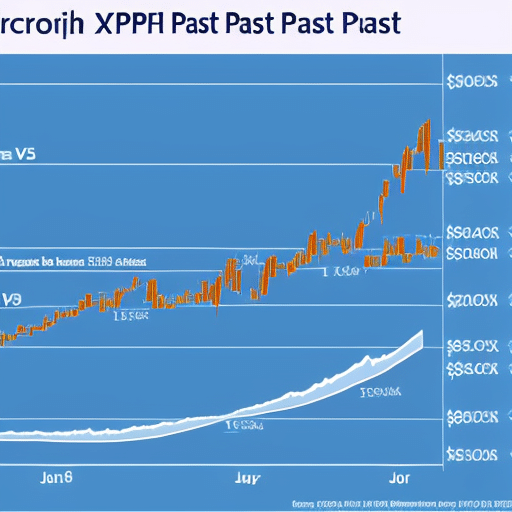Xrp Liquidity Trends
Ripple (XRP) is a cryptocurrency that has gained significant attention and traction in the digital asset market. Its liquidity, which refers to its ability to be easily converted into other tokens or fiat currencies, is an important measure of its success. This article will examine XRP’s historical liquidity trends, how its liquidity affects its market capitalization and price volatility, the impact of institutional investment on XRP’s liquidity, and what this means for the future of cryptocurrency markets. By understanding these factors, investors can make more informed decisions when investing in XRP.
Overview of XRP
XRP is a cryptocurrency created by Ripple Labs and released in 2012, which has grown to become one of the most popular cryptocurrencies in the world. It is based on an open-source protocol that facilitates near-instantaneous international payments with low fees. It has become increasingly important within the ripple ecosystem, offering a secure and cost-effective option for global payments. XRP technology utilizes blockchain technology to move large amounts of money quickly between different currencies, reducing both transaction costs and time delays. Its growing popularity is due to its scalability as well as its ability to provide reliable liquidity across multiple markets, making it ideal for businesses wanting access to a wide range of payment options. With these advantages, XRP liquidity trends have been highly favorable in recent years. This trend looks set to continue given the increasing demand for digital currencies globally.
XRP Liquidity
Liquidity refers to the ability of an asset to be bought and sold quickly in the market at prices that are close to its intrinsic value. Factors affecting liquidity include the size and depth of the market, the number of buyers and sellers, transaction costs, and regulatory factors. The level of liquidity is a key factor for investors as it can affect their ability to enter or exit a position without causing a large price movement.
Definition of Liquidity
Understanding the concept of liquidity is essential to comprehending XRP’s trends in this regard. Liquidity refers to the ability of a particular asset or security to be converted into cash quickly and easily, without incurring significant losses in market value. In terms of cryptocurrency, liquidity can be further broken down into two distinct categories: on-chain liquidity (i.e., decentralized impact) and off-chain liquidity (i.e., institutional adoption). On-chain liquidity accounts for how accessible an asset is on a blockchain network, while off-chain liquidity measures the extent to which institutional investors are able to purchase large amounts of an asset without significantly impacting the price. As both types of liquidity have become increasingly important for cryptocurrencies over time, it is essential for investors to understand their respective impacts when assessing trends in XRP’s liquidity. By understanding both types of liquidity, investors can make more informed decisions about their investments in XRP. Consequently, it is clear that factors affecting both on-chain and off-chain liquidity will play a major role in determining future trends in XRP’s overall level of liquidity.
Factors Affecting Liquidity
The ever-evolving world of cryptocurrency is akin to a chessboard; one misstep can have repercussions that ripple throughout the entire market, influencing liquidity levels for all assets. One of the primary factors affecting liquidity in the crypto world is the ratio of supply and demand for a particular coin or token. When there is an imbalance between available supply and demand, the asset’s price will often become volatile. This volatility can lead to large swings in liquidity ratios which can be seen as an indicator of overall health within a given asset’s market. Another factor that affects liquidity is how well traders are able to convert their holdings into cash quickly and easily with minimal impact on market prices. It is essential for investors to consider these factors when evaluating the potential risk associated with any investment.
The understanding of these various factors helps build a better picture of how historical trends in XRP liquidity may have been affected by events within both the cryptocurrency markets and wider economy over time.
Historical XRP Liquidity Trends
Analyzing historical XRP liquidity trends reveals fluctuations in the digital asset’s overall liquidity. Market makers are an important factor to consider when analyzing the liquidity of digital assets, as they are responsible for providing a steady flow of buy and sell orders which create liquidity. It is difficult to measure the exact amount of XRP liquidity historically, as it can be affected by a variety of factors including market sentiment and external events. However, there has been an overall increase in the amount of available XRP over time due to increased adoption and trading volume. This indicates that investors are more confident in holding onto their XRP, which has led to improved price stability and higher average daily volumes. As such, it is clear that XRP markets have benefited from increased liquidity over time. Moving forward, it will be interesting to observe how further changes in market sentiment or external events could affect the long-term trend of XRP liquidity.
XRP Liquidity and Market Capitalization
Given the increasing adoption of XRP, it is worth considering how liquidity and market capitalization are related in this digital asset. How have changes in liquidity impacted XRP’s overall market capitalization? Liquidity regulation and liquidity mining can be used to increase the amount of capital available to invest in XRP, thus increasing its market capitalization. This increased demand for the asset could subsequently cause its price to rise as well. By providing additional liquidity through these methods, investors can acquire more of the asset, which could lead to larger returns when prices appreciate.
The relationship between XRP’s liquidity and market capitalization is complex but understanding this connection can help investors make informed decisions about their investments. For example, by monitoring changes in both variables as well as other indicators such as price volatility, investors can gain an insight into how XRP may perform over time. Such insights may prove useful for making informed investment decisions regarding this digital asset. As a result, knowing the current state of both variables is essential for any investor looking to maximize their returns from investing in Ripple’s native cryptocurrency.
XRP Liquidity and Price Volatility
Examining the relationship between XRP’s liquidity and price volatility can help investors make informed decisions about their investments. Liquidity metrics, such as trading volume and spread, are essential indicators of how well a digital asset functions in the market. By measuring the amount of liquidity available for a given asset at any given time, it is possible to assess its stability and predict potential price movements. Similarly, an analysis of the price dynamics in relation to liquidity metrics can provide insights into how volatile a particular digital currency may be. Furthermore, comparing different cryptocurrencies with similar liquidity characteristics may help investors identify assets that offer more stable returns over time. Overall, examining XRP’s liquidity and price volatility together provides valuable insights into its market activity and helps investors make informed decisions about investing in it.
XRP Market Activity
Market activity for XRP is a key indicator of the health and future growth potential of the cryptocurrency. Trading volumes on exchanges are one metric to measure market activity, as they indicate how much trading of XRP is taking place. The number of transactions in the network is also an important indicator, providing insight into how many people are sending or receiving XRP on a daily basis. These metrics can provide valuable information about demand for the coin and its use within different markets.
Trading Volumes
Analyzing XRP trading volumes reveals that the coin’s daily dollar-denominated volume has increased steadily over the past year, with a notable peak of $1.1 billion on April 2nd 2019. This is due to a variety of factors, including an increase in liquidity ratios and positive technical analysis data. The number of transactions involving XRP has also risen significantly, suggesting that more traders are willing to invest in the currency than ever before. This can be seen in the recent average daily transaction values which have grown from approximately 5 million in early 2018 to over 8 million by mid-2019. These high levels of activity further suggest that XRP will continue to remain a desirable asset for traders looking for liquidity and profit potential.
Number of Transactions
The amount of XRP transactions taking place is a key indicator of how liquidity in the cryptocurrency markets. Ripple development has been an important factor in driving up the number of XRP transactions, as well as increasing its liquidity. Liquidity mining initiatives have been particularly successful for Ripple, and have resulted in higher trading volumes and more transactions taking place with XRP.
In addition to Ripple’s efforts, there are several other factors that determine the number of transactions involving XRP. These include exchange listings, market sentiment towards cryptocurrencies, and government regulations. All these elements play an important role in determining the level of liquidity available to investors interested in transacting with XRP. With wider adoption of cryptocurrencies and continued innovation from Ripple, it is reasonable to expect that the number of transactions involving XRP will continue to increase over time. As such, understanding the dynamics behind its liquidity trends can be valuable for investors looking to capitalize on opportunities related to this cryptocurrency.
XRP Liquidity and Exchange Listing
Discovering the impact of XRP liquidity on Exchange Listings can provide useful insights into the cryptocurrency markets. Global remittances have been a major factor in driving demand for XRP liquidity as it facilitates fast and cost-efficient transactions. Exchange listings, on the other hand, have provided an opportunity to increase the circulation of XRP tokens and expand its userbase. The following table summarizes the correlation between XRP liquidity and Exchange Listings:
| Factors | Correlation | Impact |
|---|---|---|
| Liquidity | Positive | Increase in liquidity leads to more exchange listings which further boosts circulation of XRP tokens. |
| Exchange Listings | Positive | Increased exchange listings increases circulation of XRP tokens which boosts liquidity. |
Therefore, it is evident that there is a positive relationship between Liquidity and Exchange Listings when it comes to XRP. This helps create an ecosystem where both entities can mutually benefit from each other’s presence. With this understanding, we can now move onto exploring how regulatory concerns have impacted xrp trading activity.
XRP and Regulatory Concerns
The listing of XRP on exchanges has been a key factor in its liquidity. However, the regulatory landscape and institutional involvement associated with XRP must also be taken into account when considering its liquidity. To explore this, it is important to consider the implications of regulations on XRP’s utilization.
Some of the major issues include:
- Potential for government regulations to limit or restrict trading of digital assets.
- Possible lack of clarity about how different governments around the world will view digital assets and their taxation policies.
- Uncertainty regarding whether institutions will become involved with XRP due to potential risks associated with the asset class.
- Difficulty in evaluating the market value and potential for future price movements given limited trading history of XRP compared to other digital assets.
- Concerns over whether centralised exchanges should be used as primary source for liquidity given recent security breaches experienced by these platforms.
These concerns are vital to understanding how effective regulations can be in ensuring safe and secure utilization of XRP, which is essential for improving its liquidity outlook going forward. Thus, exploring the impact that centralized exchanges have on its liquidity is necessary in order to gain a full picture of what lies ahead for XRP’s prospects in terms of liquidity growth.
Impact of Centralized Exchanges on XRP Liquidity
Centralized exchanges play a critical role in shaping XRP’s liquidity landscape, and their impact must be carefully evaluated. The fees associated with centralized exchanges can have a significant effect on trading costs and liquidity costs for traders who use XRP. While these fees are typically small, they can add up to large amounts when multiple trades are conducted. Furthermore, it is important to note that centralized exchanges often set the price of XRP as determined by the market pressures of buyers and sellers, which may influence liquidity levels in unexpected ways. Generally speaking, centralized exchanges bring more volume to the XRP markets but this does not always ensure higher levels of liquidity or lower trading fees. As such, it is important to understand how each exchange influences the overall liquidity landscape when assessing the state of XRP markets. By doing so, investors can make informed decisions about where best to trade or invest in XRP while also keeping an eye on liquidity costs at different exchange locations. Consequently, understanding how individual exchanges impact the larger picture helps traders better navigate the complexities of cryptocurrency markets. With this knowledge in hand, investors will be better prepared to achieve their financial goals within XRP markets and beyond.
Impact of Decentralized Exchanges on XRP Liquidity
Decentralized exchanges offer a distinct alternative to centralized exchanges, offering potential benefits to XRP traders in terms of liquidity and fees. Decentralized finance (DeFi) platforms allow users to trade XRP derivatives such as futures contracts, options, and swaps without the need for an intermediary. These decentralized exchanges provide greater liquidity than their centralized counterparts because they allow anyone with access to the internet to trade digital assets without relying on a third party. This increased level of accessibility is further enhanced by crypto-derivatives, which are financial instruments that use derivative products such as futures and options to increase or decrease exposure to particular asset classes based on market conditions.
The table below outlines several advantages of decentralized exchanges when compared to centralized exchanges:
| Advantages | Centralized Exchanges | Decentralized Exchanges |
|---|---|---|
| Liquidity | Low | High |
| Fees | High | Low |
| Security | Moderate | High |
| Accessibility | Limited | Universal |
By providing more accessible trading opportunities for XRP traders, decentralized exchanges have been able to increase liquidity levels in the market and reduce fees associated with trading activities. This has enabled traders around the globe access better prices and tighter spreads while reducing their risk exposure due to increased security measures. As such, these advancements are likely playing an important role in shaping XRP liquidity trends moving forward into 2021 and beyond. This transition from centralization towards decentralization will be further explored in the next section focusing on ‘XRP liquidity and regulatory changes’.
XRP Liquidity and Regulatory Changes
As we transition into 2021, the implications of regulatory changes on XRP liquidity become increasingly apparent. With global regulators such as the SEC and CBDC’s in countries like China introducing more stringent rules around tokenization and AML compliance, businesses must now take a much closer look at how to navigate these regulations when dealing with XRP. This is especially true for exchanges looking to facilitate XRP transactions, as they must be compliant with all local laws. As such, understanding the current landscape of regulation is an important first step in ensuring that any exchange offering XRP services remains compliant with applicable laws.
In addition to understanding the regulatory environment, it is essential for businesses to keep abreast of new developments in order to remain ahead of potential changes that could affect their business operations involving XRP. For instance, recently there has been increased focus on institutional adoption of digital assets such as XRP which has led to more competition within the space. By remaining aware of possible shifts in industry trends, firms can position themselves strategically so that they can maximize their chances for success while navigating the ever-changing regulatory landscape surrounding XRP liquidity.
Impact of Institutional Adoption on XRP Liquidity
The influx of institutional investors into the digital asset space has dramatically impacted the liquidity dynamics of certain tokenized assets, creating an environment ripe for market volatility. In particular, XRP has experienced a surge in liquidity as a result of increased institutional adoption. This has had an immediate effect on exchange fees, with many platforms offering reduced rates for higher volume trades to attract more institutional traders. Additionally, exchanges have implemented ‘liquidity mining’ schemes which reward users for providing liquid markets and reduce the cost of trading. These strategies improve the liquidity of XRP and increase its attractiveness to potential investors, making it a viable option for those seeking to add cryptoassets to their portfolios. As such, institutional adoption has been instrumental in improving XRP’s liquidity landscape and is likely to continue driving further growth in the near future. Consequently, understanding how these developments could affect current or future investments is essential for any investor looking to capitalize on this burgeoning asset class.
How to Invest in XRP
The previous subtopic discussed the impact of institutional adoption on XRP liquidity. Now, we turn to how to invest in XRP. Before investing, it is important to understand the various investment strategies available and the associated risk management for each strategy. Some investors may prefer a buy-and-hold approach, while others may choose a short-term trading strategy with higher risk but potentially greater returns. As with all investments, understanding the underlying asset is key; therefore, research into XRP’s technology and use cases should be completed before investing in order to gain an understanding of its long-term potential value. With this knowledge, investors can make informed decisions about where and how to allocate their capital when investing in XRP. Ultimately, any successful investor must understand their own risk tolerance and tailor an investment strategy accordingly. By doing so, they can maximize their chances of success when investing in XRP or any other digital asset. Having explored these considerations for how to invest in XRP, it is now time to look at how liquidity affects the future prospects of cryptocurrency markets as a whole.
XRP Liquidity and the Future of Cryptocurrency
Cryptocurrency markets are experiencing rapid growth, with the overall market capitalization rising from $150 billion in 2017 to more than $1.5 trillion in 2021. XRP is one of the major players in this space due to its liquidity and economic incentives for investors. Liquidity is a key factor for any cryptocurrency, and it refers to the ease at which an asset can be converted into cash or other assets without significantly affecting its price. XRP has high levels of liquidity as compared to other cryptocurrencies, making it attractive for investors who want quick access to their funds or wish to immediately reinvest them elsewhere.
The future of XRP will depend on the success of alternative use cases that leverage its unique features such as fast transaction times and low fees. These features provide economic incentives that make it appealing for businesses seeking cost-efficient payment solutions or financial institutions looking for faster settlement capabilities. As more entities see these benefits, they may choose XRP over other cryptocurrencies, thereby increasing its liquidity and value even further.
Frequently Asked Questions
What are the advantages of investing in XRP?
Investing in XRP offers potential advantages in terms of adoption and liquidity growth. XRP’s high transaction speeds, low fees, and scalability make it an attractive choice for financial institutions. Additionally, its global reach provides increased access to a larger customer base.
How can institutional investors increase XRP liquidity?
Institutional investors can increase XRP liquidity by promoting global adoption and creating liquidity pools. Through analytical research, investors can assess the potential of these strategies to improve market efficiency and drive greater capital inflows.
What is the impact of decentralized exchanges on XRP liquidity?
Decentralized exchanges have had a positive impact on global markets by providing access to wider liquidity pools, resulting in increased trading volume and improved liquidity.
What measures are being taken to address regulatory concerns surrounding XRP?
RippleNet and the XRP Ledger are being monitored for regulatory compliance as measures are taken to address concerns. These include enhanced know-your-customer protocols, continuous reporting of suspicious activity, and improved platform security.
What are the potential risks associated with investing in XRP?
Investing in XRP can be risky, as transaction speeds and liquidity management are unpredictable. It is like navigating a ship in choppy waters, where you never know when the next wave will come crashing down. Careful research is needed to understand the real risks associated with investing in this asset.





 Bitcoin
Bitcoin  Ethereum
Ethereum  Tether
Tether  XRP
XRP  USDC
USDC  TRON
TRON  Lido Staked Ether
Lido Staked Ether  Dogecoin
Dogecoin  Figure Heloc
Figure Heloc  Cardano
Cardano  WhiteBIT Coin
WhiteBIT Coin  Wrapped stETH
Wrapped stETH  Bitcoin Cash
Bitcoin Cash  Wrapped Bitcoin
Wrapped Bitcoin  USDS
USDS  Wrapped eETH
Wrapped eETH  Binance Bridged USDT (BNB Smart Chain)
Binance Bridged USDT (BNB Smart Chain)  Chainlink
Chainlink  Monero
Monero  WETH
WETH  LEO Token
LEO Token  Zcash
Zcash  Stellar
Stellar  Hyperliquid
Hyperliquid  Coinbase Wrapped BTC
Coinbase Wrapped BTC  Ethena USDe
Ethena USDe  Litecoin
Litecoin  Sui
Sui  Avalanche
Avalanche  Hedera
Hedera  sUSDS
sUSDS  USDT0
USDT0  Shiba Inu
Shiba Inu  Dai
Dai  Uniswap
Uniswap  PayPal USD
PayPal USD  Mantle
Mantle  Cronos
Cronos  World Liberty Financial
World Liberty Financial  Toncoin
Toncoin  Ethena Staked USDe
Ethena Staked USDe  Canton
Canton  Polkadot
Polkadot  USD1
USD1  Rain
Rain  MemeCore
MemeCore  Aave
Aave  Bitget Token
Bitget Token